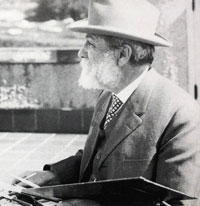LOCKWOOD DE FOREST PAINTINGS FOR SALE & BIOGRAPHY
LOCKWOOD DE FOREST
American, 1850–1932
BIOGRAPHY
“One of four children of a prosperous and socially prominent New York family, Lockwood de Forest grew up in New York City and on Long Island at Nethermuir, the family summer estate near Cold Spring Harbor. His parents, like so many others of their class, believed in the educational benefits of travel, and young Lockwood accompanied them to Europe several times, the first visit having been made in 1864. In keeping with his growing passion for the visual arts, Lockwood de Forest's subsequent journeys, in large part, were to be devoted to painting and collecting. As a budding artist, de Forest was privileged to enjoy the tutelage of Frederic Edwin Church (1826-1900), one of America's most celebrated painters, to whom he was distantly related on his mother's side and to whom his parents were close. The young de Forest visited many sites with Church during his second European trip in 1869, including the Acropolis at Athens. He also frequented Church's studio in Rome and, after his return to the United States, saw a great deal of the senior artist and studied with him informally…
“In 1879 Lockwood de Forest became partners with Louis Comfort Tiffany, Samuel Colman, and Candace Wheeler in the interior decorating enterprise, Associated Artists. After de Forest's marriage in November of 1880 to Meta Kemble, a du Pont, the young couple set off for India, a honeymoon and business trip combined, from which they would not return until the summer of 1882. It was a journey that was to profoundly reorient de Forest's taste in favor of Indian decorative design. During his time in India, de Forest became responsible for commissioning and collecting decorative art (including the establishment of a workshop in Ahmadabad in 1881) for the showrooms and clients of Tiffany. The business showed many signs of success due to the talents and very considerable connections of the partners, and their work included commissions from some of the most prominent Americans of the age including President Chester A. Arthur, Ogden Goelet, Henry Havemeyer, Mark Twain, and Cornelius Vanderbilt II.
“On his travels and at home, Lockwood de Forest painted and exchanged artistic ideas with some of the most prominent American artists of the day, including Church, Jervis McEntee (1828-1891), Sanford Robinson Gifford (1823-1880), and John Frederick Kensett (1816-1872). Between 1872 and 1883, his familiarity with the works of major American painters of his generation was assured by his tenancy at New York's Tenth Street Studio Building, architect Richard Morris Hunt's experimental structure erected entirely for the use of artists. In the late 1850s and through the 1860s, this facility was the place to find the country's most significant Hudson River School painters. Many were there beyond that decade as well. Indeed, de Forest's eleven years in the building found him in the company of America's greatest painters, among them Church, who rented a studio between 1858 and 1889, Winslow Homer (1836-1910), a tenant between 1871 and 1880, and William Merritt Chase (1849-1916), who painted and showed his work on Tenth Street between 1878 and 1895.
“The 1890s found de Forest well established as an interior decorator and architectural consultant with clients such as Andrew Carnegie. His travels abroad (India 1892; Europe 1898) and in the States (Vermont, Maine, and California) presented continuing opportunities to paint. In 1898, de Forest was made a full member of the National Academy and he became treasurer of the Academy in 1899. It is possible that Lockwood de Forest went to California for the first time in 1889, but it is certain from his dated work that by 1902, he was spending his winters in the state, at Santa Barbara and occasionally on the Monterey Peninsula. After a good many trips west, de Forest built a home at Santa Barbara in 1915 where his son Lockwood de Forest III, who could claim Rudyard Kipling as his godfather, became one of the state's most famous landscape architects, his name attached in perpetuity to a now ubiquitous variety of Rosemary, de Foresti.”
Joseph Goldyne, “Lockwood De Forest’s Grand Pictorial Diary”, Lockwood De Forest - Plein-Air Oil Sketches [Exhibition catalogue], Richard York Gallery, New York, 2001, pp. 9-12
Lockwood de Forest Museum Collections:
Alaska State Museum, Juneau, Arkansas
Art Institute of Chicago, Chicago, IL
Baltimore Museum of Art, Baltimore, MD
Brooklyn Museum, Brooklyn, NY
Bryn Mawr College, Pennsylvania, PA
Century Association, New York, NY
Cleveland Museum of Art, Cleveland, OH
Cooper Hewitt Smithsonian Design Museum, New York, NY
Fine Arts Museums of San Francisco, San Francisco, CA
Heckscher Museum of Art, Huntington, NY
Herron Art Institute, Indianapolis, IN
Huntington Museum of Art, Huntington, WV
Indianapolis Museum of Art, Indianapolis, IN
Lahore Museum, Pakistan
Mark Twain House and Museum, Hartford, CT
Merchant Ivory Foundation, Claverack, NY
Morse Museum of American Art, Winter Park, FL
National Academy of Design, New York, NY
Naulakha, Dummerston, VT
New York University’s Bronfman Center for Jewish Student Life, New York, NY
New York Historical Society, New York, NY
Olana State Historical Site, Hudson, NY
Santa Barbara Historical Society Museum, Santa Barbara, CA
The Metropolitan Museum of Art, New York, NY



